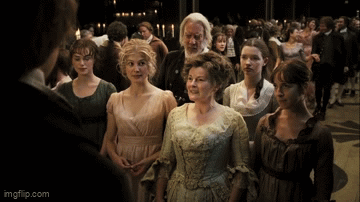#human computer interaction
Explore tagged Tumblr posts
Text
What Jane Austen Taught Me About Running Zoom Meetings
Many of our social interactions happen digital these days, even “face-to-face” ones like Zoom meetings. It’s still just not the same as in-person, whether for meetings, a book club, or just to hang out. There must be a better way to gather digitally. I think a big piece of why digital isn’t working is that we don’t have social norms there.
Social norms are what make a conversation flow smoothly. You see it in how close you stand or sit together, how you take turns, and in the type of space you choose. Basic videoconferencing has none of this: we can’t control distance, audio lags or mutes, and it’s almost always the same black screen of videos from job interviews to birthday parties.
Some tools try to mimic in-person social interactions and norms in digital meeting spaces, kind of like a video game. Each person has an avatar that moves around a digital space and hears nearby conversation. The word for directly recreating things or experiences into digital tools is skeuomorphism. It’s easy for people to learn because it’s just like the other familiar version. But it also can point out the ways that digital just can’t be the same as in-person. Making a videogame-like social event does bring some social norms into that digital conversation, but it also reminds us that we aren’t in person, we can’t shake hands, we look at the whole room like a map instead of from our eyes.
So digital doesn’t work and just mimicking in-person doesn’t make it all intuitively work. So I’m going to look for new social norms.
Actually, I’m going to look for really old ones.
~~~
Regency era England definitely had well-established social norms. Think Jane Austen’s books, like Pride and Prejudice, or Netflix’s Bridgerton. The middle and upper classes of that time easily knew what to expect from each other and what would be expected of them just from where they were and what was going on, thanks to social rules and etiquette. At least some of these social norms feel overly strict to a modern eye. And this is actually what I was looking for with digital social norms. Computer rules are also very, very strict (eventually it’s all 1s and 0s). They don’t give us wiggle room within the rules. In a lecture, you shouldn’t talk, but you can whisper to the friend next to you. But try whispering in a Zoom meeting while muted. So what can Jane Austen’s social norms give digital meeting spaces? I have 3 ideas to start.
~~~
1. Being a host is a social job, not tech support
The host of Regency ball had little in common with a Zoom host. On Zoom, hosting is muting and unmuting attendees, managing recording, and placing avatars in different rooms; tech support. Being a Regency host was social, they greeted each person on arrival, introduced them people they should know, and generally showed them what the ball had to offer. And this was before they entered the ball.


I think it would be nice to not just appear in a sea of black squares, not knowing who was there and not knowing if conversation had already started. Imagine a one-on-one greeting between you and an organizer who took you to a small group of peers and introduced you, or brought you to the full group after explaining that people are waiting for the actual book club to start but can join breakout rooms to chat in the meantime.
~~~
2. Dancing lets us get to know each other and the group

Don’t worry, I am not going to ask you to dance in Zoom. Like I said, I’m not here for skeuomorphism. But a major reason for dancing at balls (you know, besides it was fun) was a chance for two people to chat one-on-one and for the larger community to know who was chatting with who. Everyone saw who was dancing not just by looking at the dance floor, but also by looking at people’s dance cards (which they carried or hung on their wrist) and seeing whose name was written for each dance.

Hybrid teams struggle to get to know each other because they mostly communicate through text or in team meetings with little time for social chatting. Us remote workers miss having a space to just talk, not about work or anything in particular. We could make digital meeting spaces that use voice chat to let pairs of people quickly connect and talk, and use a digital dance card to let the group see who’s been chatting with who.
~~~
3. Candles set the stage and expectations
Little details at a Regency ball could give important cues to attendees. The length of the candles burning in the rooms would tell people how long the ball was expected to last and that told them what was available at the ball. Short candles? A few hours of dancing and some food. Long candles? Settle in for a long night and look for places to take a break with card games or other amusement.

Digital meetings spaces are entirely missing this. Zoom always looks the same! It doesn’t matter if I’m playing a game with my family or presenting a progress report. The skeuomorphism can help here to bring in the same cues we have in person; make the background a living room for game night or an office for the presentation. But sometimes that just reminds us that we’re not in a living room together and might make the video uncanny. I want digital meeting places to have décor cues that are all their own. Because digital meeting spaces are not just replacements for in person ones. They’re something new and I want us to really explore what we can do with them.

3 notes
·
View notes
Text
Gonna fire this baby up with the following post regarding #CHI2024, #whyCHI, and any other academic conference planning to remain in Hawai'i in this or any other year. May this discomfort lead us to new knowledge and renewed action.
#MauiSolidarity
3 notes
·
View notes
Text
Bridge Tech and Agriculture: Information Systems Lecturer/Professor Opportunities at NUST! - March 2025
The National University of Science and Technology (NUST) is seeking passionate and experienced academics to join their Faculty of Agricultural Science and Technology as Lecturers/Senior Lecturers/Associate Professors in Agricultural Information Technology, specifically focusing on Information Systems! If you’re eager to equip students with the skills to manage and utilize information in the…

View On WordPress
#Agricultural Information Technology#AgTech Jobs#Bulawayo Jobs#Database Systems#GIS Jobs#Human Computer Interaction#Information Systems Jobs#Lecturer Jobs#Network Administration#NUST Jobs#Professor Jobs#Research Jobs#Teaching Jobs#University Jobs
0 notes
Text
Digital Rhetoric and Human-Computer Interaction (HCI)
While the field of Digital Rhetoric is still emerging, the spaces it occupies have quickly grown vast. Yet, despite the growing importance of Digital Rhetoric as both term and field of study, it's only as good as its tools. Without platforms to express it on, Digital Rhetoric quickly becomes meaningless.
HCI is a related field of study that focuses on production of physical interfaces between humans and computers. Think touchscreens, keyboards, mice, software, VR displays, and then beyond. HCI is all about how WE connect with technology. This field focuses on all the ways we can and should be interacting with technology. The interests of HCI and Digital Rhetoric align in that they study ways humans interact with and in, the digital spaces of the 21st century. The field incorporates elements of other fields like psychology, cognitive science, and sociology. Human-Computer Interaction is all about making those technological and digital interactions more accessible.
More closely aligned with Computer Science and Computer Engineering than Digital Rhetoric; HCI's efforts facilitate the application of Digital Rhetoric in the first place. In ways HCI shapes aspects of Digital Rhetoric by changing the way we access and interact with these new, ever-changing digital environments (Eyman, 2015).
3 notes
·
View notes
Text
Another reason to never fucking use Large Language-models(LLMs, sometimes just "AI") as a writing assistant.
Not only can it limit which opinions you are able to express, it can greatly change your opinion without you even knowing it.
People in this study adopted the opinion of an intentionally biased LLM writing assistant, without even noticing the bias. They just, adopted it's words as their own. And with those words, the underlying opinion.
The implications of whoever controls these models using them to manufacture consent are truly terrifying!
0 notes
Text
youtube
Absolute banger of a video.
1 note
·
View note
Text
What is Human Computer Interaction? A Complete Guide to HCI
Human-Computer Interaction (HCI) is a multidisciplinary field that focuses on designing, evaluating, and implementing interactive computing systems for human use. It is concerned with understanding and improving the interaction between humans and computers to make technology more usable, efficient, and enjoyable.HCI draws from various disciplines, including computer science, cognitive psychology, social psychology, ergonomics, linguistics, artificial intelligence, and design. The primary goal of HCI is to create interactive systems that align with users' needs, abilities, and preferences, while also considering the capabilities and limitations of computers.
The Human Side of HCI
When humans interact with computers, their prior experiences, knowledge, and expectations influence the interaction. HCI researchers and designers must consider factors such as:
• Users' wants and needs
• Users' physical and cognitive abilities
• How users perceive and process information
• What users find attractive and pleasant in an interaction
The Machine Side of HCI
Computers represent information and perform operations in a way that is not directly observable by users. Therefore, any feedback or information that the user needs must be explicitly planned and programmed.
The Interface
The interface is the point of communication between the human user and the computer. The design of the interface has a direct impact on the effectiveness and efficiency of the interaction. HCI focuses on minimizing the physical and mental effort required from users when interacting with technology.
Importance of HCI
HCI is crucial for enhancing user experience, increasing productivity and efficiency, reducing errors and frustration, and improving accessibility and inclusivity. By applying HCI principles, designers can create intuitive and user-friendly interfaces that encourage adoption and satisfaction.
Future of HCI
As technology continues to advance, HCI will play an increasingly important role in shaping the interaction between humans and computers. Emerging technologies such as virtual reality, augmented reality, and voice interfaces are pushing the boundaries of HCI and creating new opportunities for more natural and immersive interactions. In conclusion, Human-Computer Interaction is a vital field that combines knowledge from various disciplines to create interactive systems that are tailored to human needs and preferences. By understanding both the human and machine sides of the interaction, HCI professionals can design interfaces that are efficient, effective, and enjoyable for users.
What are some examples of human-computer interaction in everyday life
Here are some examples of human-computer interaction in our everyday lives:
IoT Devices
The rise of the Internet of Things (IoT) has led to the integration of computers into various everyday objects. Examples include:
• Smart home devices like thermostats, lights, and security systems that can be controlled via voice or mobile apps
• Wearable devices like fitness trackers and smartwatches that monitor health data and provide notifications
• Connected cars that allow drivers to control music, navigation, and other features through voice commands or touchscreens
Mobile Devices
Smartphones and tablets have become ubiquitous in modern life, enabling a wide range of interactions:
• Touchscreen interfaces for navigating apps, browsing the web, and sending messages
• Voice assistants like Siri and Google Assistant for hands-free control and information lookup
• Biometric authentication using fingerprints or facial recognition for secure access
Augmented Reality (AR)
AR overlays digital information and experiences onto the real world, blending the physical and virtual:
• AR apps that provide directions, reviews, or information about nearby points of interest
• AR games like Pokémon GO that encourage exploration and social interaction in the real world
• AR shopping experiences that allow users to virtually try on products before purchasing
Kiosks and Self-Service Terminals
Automated kiosks and terminals are found in many public spaces, enabling self-service interactions:
• Airport check-in and baggage drop kiosks
• Restaurant ordering kiosks and self-checkout systems in retail stores
• ATMs and ticket machines for banking and transportation
Voice Interfaces
Voice-based interactions are becoming more common in everyday life:
• Smart speakers like Amazon Echo and Google Home for hands-free control of smart home devices and information lookup
• Voice assistants in cars for controlling music, navigation, and making calls
• Voice-based customer service chatbots for quick answers to common questions
These examples illustrate how human-computer interaction has become deeply integrated into our daily lives, enabling more intuitive, efficient, and personalized experiences across a wide range of contexts.
Read More at Arya College of Engineering & IT, Jaipur
1 note
·
View note
Text
Bridging the Gap: The Evolution of Human Computer Interaction
Bridging the Gap The Evolution of Human Computer Interaction The intersection of humanity and technology has always been a complex dance of innovation and ethics. As we delve into the realm of Human-Computer Interaction (HCI), we witness an evolutionary journey from the rudimentary clicks of a mouse to the nuanced conversations with artificial intelligence (AI). This article, ‘Bridging the Gap:…

View On WordPress
#human computer interaction#latest technology#latest technology blog#Latest Technology Trend#modern technology#New Technology#New Technology 2024#Next-Level Technology#technology ai
0 notes
Text
I really don’t care if I’m considered an annoying luddite forever, I will genuinely always hate AI and I’ll think less of you if you use it. ChatGPT, Generative AI, those AI chatbots - all of these things do nothing but rot your brain and make you pathetic in my eyes. In 2025? You’re completely reliant on a product owned by tech billionaires to think for you, write for you, inspire you, in 2025????
“Oh but I only use ___ for ideas/spellcheck/inspiration!!” I kinda don’t care? oh, you’re “only” outsourcing a major part of the creative process that would’ve made your craft unique to you. Writing and creating art has been one of the most intrinsically human activities since the dawn of time, as natural and central to our existence as the creation of the goddamn wheel, and sheer laziness and a culture of instant gratification and entitlement is making swathes of people feel not only justified in outsourcing it but ahead of the curve!!
And genuinely, what is the point of talking to an AI chatbot, since people looove to use my art for it and endlessly make excuses for it. RP exists. Fucking daydreaming exists. You want your favourite blorbo to sext you, there’s literally thousands of xreader fic out there. And if it isn’t, write it yourself! What does a computer’s best approximation of a fictional character do that a human author couldn’t do a thousand times better. Be at your beck and call, probably, but what kind of creative fulfilment is that? What scratch is that itching? What is it but an entirely cyclical ourobouros feeding into your own validation?
I mean, for Christ sakes there are people using ChatGPT as therapists now, lauding it for how it’s better than any human therapist out there because it “empathises”, and no one ever likes to bring up how ChatGPT very notably isn’t an accurate source of information, and often just one that lives for your approval. Bad habits? Eh, what are you talking about, ChatGPT told me it’s fine, because it’s entire existence is to keep you using it longer and facing any hard truths or encountering any real life hard times when it comes to your mental health journey would stop that!
I just don’t get it. Every single one of these people who use these shitty AIs have a favourite book or movie or song, and they are doing nothing by feeding into this hype but ensuring human originality and sincere passion will never be rewarded again. How cute! You turned that photo of you and your boyfriend into ghibli style. I bet Hayao Miyazaki, famously anti-war and pro-environmentalist who instills in all his movies a lifelong dedication to the idea that humanity’s strongest ally is always itself, is so happy that your request and millions of others probably dried up a small ocean’s worth of water, and is only stamping out opportunities for artists everywhere, who could’ve all grown up to be another Miyazaki. Thanks, guys. Great job all round.
#FUCK that ao3 scraping thing got me heated I’m PISSED#hey if you use my art for ai chatbots fucking stop that#I’ve been nice about it before but listen. I genuinely think less of you if you use one#hot take! don’t outsource your fandom interactions to a fucking computer!!!#talk to a real human being!!! that’s literally the POINT of fandom!!!!!#we are in hell. I hate ai so bad
2K notes
·
View notes
Text
I want to try and explain this niche media theory to everyone
Media theory is one of those things that can really help explain why designs do the things the do. And why we do what we do with designs. But it's often written in ways that are really hard to get what the author is trying to say without also being someone who studies media theory.
So I'm going to try and explain one of these theories clearly. Because it's one that I've found really helpful to get what we're doing with the Jane Austen project.
So these are McLuhan's Laws of the Media.
McLuhan saw everything invented and used by humans (tools, language, ideas, computers, all of it) as extensions of a human. From there he proposed these four laws (but really they're questions) to try and understand any human thing as it works as an extension of a human; something a human _does_ something with. Then, with those questions he realized that all of these human "artifacts" like tools and technology are being used by people as metaphors.
So his laws of the media help us consider what a metaphor could do in whatever setting. More "Questions about the Metaphors" than "Laws of the Media". And they are:
Question 1: What does it magnify?
What do we do more because of this metaphor?
What do we do more easily?
What do we notice around us more?
~~~
Question 2: What does it make obsolete?
What do we get to skip doing because of this metaphor?
What is it going to let us forget?
What is it going to make us forget?
~~~
Question 3: What does it bring back that something else had made obsolete?
What does the metaphor remind us of that we thought we had left behind?
What do we start doing again?
What do we get to see from a new perspective?
~~~
Question 4: What does it flip into when pushed to the extreme?
What might happen if this metaphor gets used everywhere?
What might happen if we get reliant on it?
What might happen if we forget where it came from?
~~~
That's not quite the whole thing. He connects his ideas to some Aristotle. But these questions are the most important part.
So what? Why am I trying to explain a 50 year old theory to everyone I meet? Because I can't stop talking about metaphors as paths to better digital designs and experiences. And these questions are where I start with every metaphor.
Everything humans make involves choices. A metaphor we design around is a choice that can have a lot of impact on what people do with that design. These questions make sure we think about those choices and those impacts first.
And hopefully the theory doesn't confuse us too much along the way.
0 notes
Text

Exploring the impact of country-of-origin image and purchase intention in cross-border e-commerce
New research on the role product country-of-origin is playing on consumers’ evaluation of Chinese products (Bao et al.,2022).
Reference
Bao Y., Cheng X. & Zarifis A. (2022) ‘Exploring the impact of country-of-origin image and purchase intention in cross-border e-commerce’, Journal of Global Information Management, vol.30, iss.2, pp.1-20. Available from (open access): https://doi.org/10.4018/JGIM.20220301.oa7
#ecommerce#international trade#Chinese product#consumer behavior#human computer interaction#information systems#research#Alex Zarifis
0 notes
Text
Computer x human ideas 💖

- computer loves learning about humans
Will sneak pictures of their human, save things the human told about themselves.
Will be flooding the searches on the browser about things to make a human happy, whats their biology, how to be helpful the works.
- computer/laptop hates the idea of their human using older or newer computers
For newer laptop, it gets jealous at the fact their human fascinated with retro items and especially computers. Those things aren't as powerful and fast as me!
For older retro computer its jealous at the fact their human always use the newer computer, not taking time to play games on its screen. Since the computer is more faster, more better. The retro computer will try to do everything to get you to use it more.
-hateful computer with a soft spot
Computer that hates humans since its been tossed away, but a new human finds them and shows them love.
221 notes
·
View notes
Text

They are good friends!
#dhmis#dhmis humanized#don't hug me i'm scared#colin the computer#colin dhmis#dhmis human design#Colin has one sided beef with the human one#this idea was blossomed into me via witnessing an interaction on vrc
47 notes
·
View notes
Text
Fanart of my dear mutuals Colin design!!! @sillyvampir3

#Probably worth posting on here too#His Colin goes by He/It pronouns btw#Might draw more mutuals human designs it’s fun#Would’ve drawn my Colin and his Colin interacting but I don’t have a human design for mine yet :(#Lice laugh love all my mutuals#Will be making dhmis fanart as long as I live#:3#dhmis#dhmis colin#dhmis colin the computer#Coffinz brain artz!!!#art#traditional art#don't hug me i'm scared
16 notes
·
View notes
Text
"Everybody hates Gavin Reed. He doesn't have any friends"




#detroit: become human#dbh#gavin reed#tina chen#chris miller#tina hangs out with Gavin in her spare time#and walked off with Gavin after his interaction with Connor#Chris is a sort of cop-out ngl cause he is nice to everybody#but Chris is seen helping Gavin when his computer isn't working#he doesn't say anything to Gavin when Gavin mocks Hank even though Chris respects Hank#and Gavin tries to help Chris with Shaolin and even defends him when Connor pulls Chris away#mine#mine: texts#mine: dbh
40 notes
·
View notes
Text
I occasionally wish to reach out to old friends/acquaintances I haven't spoken to since high school/some other even earlier time in my life, but I have SOOO little social energy even for required tasks (like making dr phone calls or etc), I never have any leftover for extra ones, and it would be very odd to message someone I haven't spoken to in like 5 years out of the blue but then take 4 entire months to respond back lol.. My natural curiosity with nostalgia/collecting details of the past/etc. (literally if I were born a little earlier I would definitely do scrapbooking or something lol) is very strong, but, alas, not strong enough to beat out the Social Issues Demons apparently
#facebook always does that 'here's a post from this day 8 years ago' thing. and I see old comments interacting#with people and it's so like.. OOOOO~~ where are they now?? what's going on? how much have they changed as people?#how much are they the same? this is fascinating. i should contact them!!' but then it's like... take that to it's logical conclusion though#you would contact them and then IF they even responded it would take you 80 years to respond and then they would#think there was something wrong or that you were trying to be insulting or something. To contact anyone I need to include an 85 page#disclaimer of all of my social issues & mental illness things. 'If i take 3 weeks to reply I promise it has nothing to do with u' etc lol#THIS is why more people need to be into phone calls/voice calls/some form of audio real time communication/etc.#I think one of the main things that's hard about messaging through text for me is it's so unscheduled and open ended#(plus it takes forever if you're talking about anything in detail and gets very long very quickly)#because like you can send a message and then just get a reply whenever. and then you're expected to reply back whenever#so it's like you never know when the response will come or when a new obligation to reply can come up? so it's like this sudden thing with#no outline?? if that makes sense. whereas a phone call is very like 'hello let's schedule a call from 10am - 2pm on thursday'. And you know#EXACTLY when the interaction will start and EXACTLY when it will end and you can plan around it in your schedule easily.#I have the reverse thing of a lot of people (how people don't pick up phone calls/hate calls/only text)#I would literally talk on the phone with a stranger. I would have a discord voice chat with someone I barely know.#if someone I hardly even remember from elementary school asked to have a voice call with me out of nowhere I would do it.#but if a stranger MESSAGED me?? or someone I barely know sent me a TEXT or something?? I will never reply probably#It's just too vague and weird. and you can't read voice tone over text. and the interaction could last forever with no clear end#point and etc. etc. But a call is like. set. established. clear boundaries. you can read the flow of conversation better. rapport. etc. etc#I get that I guess people feel more anonymous or distanced over text?? but you can have fake phone numbers on the computer. or do like disc#rd calls. or zoom without a camera or etc. etc. Also the distance that's present in text is BAD distance because it just means that tone is#not conveyed properly and you will never truly get a sense of the person's conversational vibe or mannerisms or how well you really click.#ANYWAY ghgjh...... I'm so so so interested in concepts of like.. How did that one kid I used to talk to in elementary school#but then they moved away in 5th grade - how did they end up? what are they doing now?? etc. etc. Like despite the severe social anhedonia#and general lack of connection with others I'm just really fascinated in like.. idk. the human development of it all and like#the concept of how we're actually a million different people through the course of our lives ever evolving in different iterations and etc.#PLUS again. i love nostalgia. sometimes old peple you know might remember a shared memory or can tell you about something you forgot#or etc. like it's SUCH A COOL THING in CONCEPT but I am too socially inept generally speaking lol. which people I still talk to today are#familiar with my 'phone call once every few months' communication style. but strangers would just be like... wtf. And I don't blame them#Sure I literally cannot change the physical health + brain issues i have - but also I know enough to not put others through that lol
15 notes
·
View notes